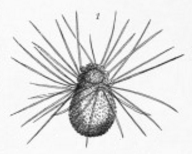|
Platyproteum
The ''Platyproteum'' are a genus of parasitic alveolates in the phylum Apicomplexa. Species in this genus infect marine invertebrates. Taxonomy This genus was described in 2009 by Sonja Reuckert and Brian Leander. There is one species in this genus - ''Platyproteum vivax''. This species was moved from the genus ''Selenidium''. It appears to be related to ''Filipodium phascolosomae''. Description This parasite is tape like. Life cycle The parasite infects the gastrointestinal tract and is presumably transmitted by the orofaecal route but the details of this mechanism are presently unknown. References Conoidasida Apicomplexa genera {{Apicomplexa-stub ... [...More Info...] [...Related Items...] OR: [Wikipedia] [Google] [Baidu] |
Apicomplexa
The Apicomplexa (also called Apicomplexia; single: apicomplexan) are organisms of a large phylum of mainly parasitic alveolates. Most possess a unique form of organelle structure that comprises a type of non-photosynthetic plastid called an apicoplastwith an apical complex membrane. The organelle's apical shape is an adaptation that the apicomplexan applies in penetrating a host cell. The Apicomplexa are unicellular and spore-forming. Most are obligate endoparasites of animals, except '' Nephromyces'', a symbiont in marine animals, originally classified as a chytrid fungus, and the Chromerida, some of which are photosynthetic partners of corals. Motile structures such as flagella or pseudopods are present only in certain gamete stages. The Apicomplexa are a diverse group that includes organisms such as the coccidia, gregarines, piroplasms, haemogregarines, and plasmodia. Diseases caused by Apicomplexa include: * Babesiosis ('' Babesia'') * Malaria (''Plasmodium'') * Cr ... [...More Info...] [...Related Items...] OR: [Wikipedia] [Google] [Baidu] |
Eukaryota
The eukaryotes ( ) constitute the Domain (biology), domain of Eukaryota or Eukarya, organisms whose Cell (biology), cells have a membrane-bound cell nucleus, nucleus. All animals, plants, Fungus, fungi, seaweeds, and many unicellular organisms are eukaryotes. They constitute a major group of Outline of life forms, life forms alongside the two groups of prokaryotes: the Bacteria and the Archaea. Eukaryotes represent a small minority of the number of organisms, but given their generally much larger size, their collective global biomass is much larger than that of prokaryotes. The eukaryotes emerged within the archaeal Kingdom (biology), kingdom Asgard (Archaea), Promethearchaeati and its sole phylum Promethearchaeota. This implies that there are only Two-domain system, two domains of life, Bacteria and Archaea, with eukaryotes incorporated among the Archaea. Eukaryotes first emerged during the Paleoproterozoic, likely as Flagellated cell, flagellated cells. The leading evolutiona ... [...More Info...] [...Related Items...] OR: [Wikipedia] [Google] [Baidu] |
SAR Supergroup
SAR is a highly diverse clade of eukaryotes, often considered a supergroup, that includes stramenopiles (heterokonts), alveolates, and rhizarians. It is a node-based taxon (under the Sar name), including all descendants of the three groups' last common ancestor, and comprises most of the now-rejected Chromalveolata. Their sister group has been found to be telonemids, with which they make up the TSAR clade. Harosa is sometimes used synonymously with TSAR. Etymology The name SAR is an acronym derived from the first letters of its three constituent clades; it has been alternatively spelled RAS. The term Harosa (at the subkingdom level) has also been used, with Stramenopiles replaced by its synonym Heterokonta in this variant of the acronym. History of discovery Before the discovery of the SAR supergroup, stramenopiles and alveolates were classified in the supergroup Chromalveolata alongside haptophytes and cryptomonads, being believed to have acquired plastids th ... [...More Info...] [...Related Items...] OR: [Wikipedia] [Google] [Baidu] |
Miozoa
Myzozoa is a grouping of specific phyla within Alveolata, that either feed through myzocytosis, or were ancestrally capable of feeding through myzocytosis. Many protist orders are included within Myzozoa. It is sometimes described as a phylum, containing the major subphyla Dinozoa and Apicomplexa, plus minor subphyla. The term Myzozoa superseded the previous term "Miozoa", by the same authority, and gave a slightly altered meaning. Phyla Within Myzozoa, there are four phyla: *Apicomplexa – parasitic protozoa that lack axonemal locomotive structures except in gametes * Dinoflagellata – mostly marine flagellates many of which have chloroplasts * Chromerida – a marine phylum of photosynthetic protozoa * Perkinsozoa The term/group Myzozoa was not considered in a resolution of protist groups by Adl et al. 2012. Strict taxonomy only considers common traits possessed by all organisms of the group. Some organisms within each of the component groups of Myzozoa have lost the ... [...More Info...] [...Related Items...] OR: [Wikipedia] [Google] [Baidu] |
Dinozoa
Dinozoa is a group of microorganisms composed of dinoflagellates and perkinsids. It was initially coined in 1981 as a synonym of dinoflagellates, but in 2004 the name was repurposed for the evolutionary lineage or clade In biology, a clade (), also known as a Monophyly, monophyletic group or natural group, is a group of organisms that is composed of a common ancestor and all of its descendants. Clades are the fundamental unit of cladistics, a modern approach t ... of dinoflagellates and their closest relatives, the perkinsids. References {{Alveolate-stub Alveolata taxa ... [...More Info...] [...Related Items...] OR: [Wikipedia] [Google] [Baidu] |
Parasitic
Parasitism is a close relationship between species, where one organism, the parasite, lives (at least some of the time) on or inside another organism, the host, causing it some harm, and is adapted structurally to this way of life. The entomologist E. O. Wilson characterised parasites' way of feeding as "predators that eat prey in units of less than one". Parasites include single-celled protozoans such as the agents of malaria, sleeping sickness, and amoebic dysentery; animals such as hookworms, lice, mosquitoes, and vampire bats; fungi such as honey fungus and the agents of ringworm; and plants such as mistletoe, dodder, and the broomrapes. There are six major parasitic strategies of exploitation of animal hosts, namely parasitic castration, directly transmitted parasitism (by contact), trophicallytransmitted parasitism (by being eaten), vector-transmitted parasitism, parasitoidism, and micropredation. One major axis of classification concerns invasiveness: an endopar ... [...More Info...] [...Related Items...] OR: [Wikipedia] [Google] [Baidu] |
